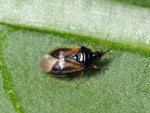Subscribe and save 10%!

Orius beetles against thrips, mealybugs, aphids, spider mites, etc.
212 SEK
Unit price perExpected delivery date: 20 December to 27 December.
Applies to orders within Sweden. For other countries - see our delivery terms .
In stock
Share
212 SEK
Unit price perBeneficial insect effective against thrips, both adults and nymphs. Available in packs of 100 or 500.
Orders placed by Sunday evening will be shipped the following Tuesday.
Orius majusculus is a Swedish species of the genus Orius in the family Orius beetles. Orius beetles are the most effective beneficial insects that can be released against thrips, they take both adults and all larval stages of most thrips species.
Orius beetles primarily eat thrips. An adult beetle can ingest 20 thrips a day, but they can also eat other pests such as spider mites, dwarf mites, aphids and mealybugs. If you only have an infestation of pests other than thrips, you should instead use beneficial insects that effectively target those pests.
Product description
The Orius beetles are delivered in a package with a mixture of adults and nymphs distributed in buckwheat husks. It is available in sizes of 100 or 500.
When attacking, about 5-10 rams/m 2 are used. How many rams you need depends on how many and how big the plants are, and the size of the attack. If the attack is severe on a large number of plants, many rams are needed, and for minor attacks and few plants, a smaller amount can be sufficient.
Generally speaking, it is better to release the rams in several rounds than to release many at one time.
However, note that there are some, more unusual, tropical thrips species that are difficult to control, where neither beneficial animals nor chemicals have a good effect. They often come home with the houseplants, are dark in color and sometimes have white stripes. One example is Echinothrips, which is particularly difficult to control.
User manual
The Orius beetles are sprinkled on the foliage of plants with thrips infestation. For plants with narrow leaves, or where it is otherwise difficult to place the beneficial insects on the leaves, you can buy bioboxes to hang on the plant ( see related product below ). Alternatively, make your own paper cones that you pour the beetles into and place on the plants.
The adult beetles can fly and spread easily in the plants. The nymphs can walk between the plants as long as the leaves touch each other. The Orius beetles are sometimes difficult to find among the plants, as they like to hide in the nooks and crannies and in the buckwheat husks they are transported with.
Orius beetles can be used both outside in the greenhouse and indoors. Indoors they do not seek out pantries, bedding or similar, but since they can fly, it is a matter of taste whether you wish to use them inside. It is not recommended to use them outdoors as they will easily fly away.
Orius beetles are active at temperatures between about 16°C and 35°C. They can also survive on pollen from flowering plants. Therefore, flowering plants can be an advantage when using Orius. Long day lengths, over 14 hours per day, are necessary for Orius to reproduce, but they also survive shorter day lengths.
Orius beetles are sensitive to various pesticides and one should therefore be careful with release after using, for example, provado/provanto sticks. The plants can be sprayed with soap before releasing Orius, in which case it needs to have dried up before release.
Feel free to combine Orius with a set of yellow sticky discs . You can also combine with swirskii predatory mites or thrips predatory mites in small bags. They work well as a complement to Orius and as a preventative against new infestations, for example after completing treatment with Orius.
Storage
Orius should be distributed to the plants immediately upon receipt. In case of emergency, they can be stored for a couple of days at 8-10°C.
- Choosing a selection results in a full page refresh.
- Opens in a new window.




